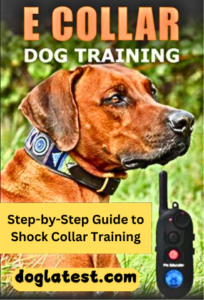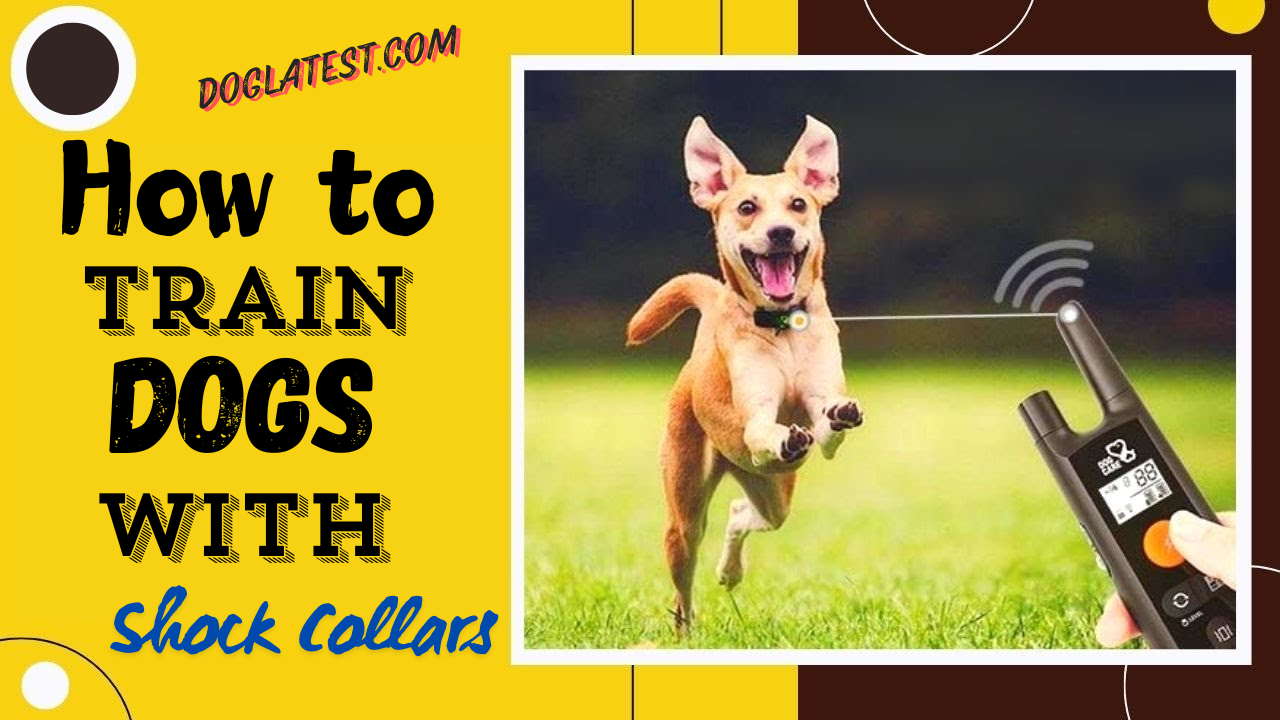Training your dog can be a rewarding experience, but it also comes with its fair share of challenges. For some dog owners, train dog with shock collar is an effective tool that, when used correctly, can help manage and correct unwanted behavior. However, it’s important to approach this training method with care, understanding, and responsibility. This guide will take you through the step-by-step process of how to train your dog with a shock collar, ensuring that both you and your dog have a positive and successful experience.
What is a Shock Collar?
A shock collar, also known as an e-collar or electronic collar, is a device used to deliver a mild electric stimulation to your dog’s neck when they exhibit undesirable behavior. The goal is not to harm the dog but to catch their attention and interrupt the unwanted behavior, providing an opportunity for redirection and correction.
Why Consider Using a Shock Collar?
Shock collars can be effective for dogs that do not respond well to traditional training methods. They are often used to address persistent behaviors such as excessive barking, aggression, or chasing. When used properly, a shock collar can reinforce commands and improve communication between you and your dog.
Common Misconceptions about Shock Collars
Many people believe that shock collars are cruel or harmful, but this is often due to misuse or misunderstanding of the tool. When used correctly, the stimulation is mild and should not cause pain. The focus should always be on humane and ethical training practices, using the collar as a last resort and combining it with positive reinforcement.
Read More: What is an E-Collar?
Understanding the Basics of Shock Collar Training

How Shock Collars Work
Shock collars are equipped with a remote control that allows you to administer a small electric stimulation to your dog. The stimulation can vary in intensity, and most modern collars also offer vibration or tone options. The key to effective training is proper timing—delivering the stimulation immediately after the undesirable behavior occurs to create a clear association.
Different Types of Shock Collars
There are several types of shock collars available, each designed for specific training needs:
- Remote-Controlled Collars: These allow you to manually control the stimulation level.
- Bark-Control Collars: Automatically deliver stimulation when your dog barks excessively.
- Invisible Fence Collars: Used to keep your dog within a specific boundary without a physical fence.
The Importance of Proper Timing and Usage
Timing is everything in shock collar training. The stimulation should be delivered at the exact moment your dog engages in unwanted behavior. If there is a delay, your dog may not make the connection between the behavior and the correction, leading to confusion and ineffective training.
Read More: Ultimate Guide to Waterproof Dog Collars
Preparing for Shock Collar Training
Assessing Your Dog’s Personality and Needs
Before introducing a shock collar, it’s crucial to assess whether this method is suitable for your dog. Some dogs are more sensitive or anxious, and a shock collar may not be the best option. Consider your dog’s temperament, the behavior you want to correct, and whether other training methods have been exhausted.
Choosing the Right Shock Collar
Select a collar that matches your dog’s size and training requirements. Ensure it has adjustable intensity levels, and start with the lowest setting. A good collar should also offer a vibration or tone mode as an alternative to shock.
Setting the Correct Intensity Level
If necessary, progressively raise the stimulation level from the lowest starting point. Your goal is to use the minimum amount of stimulation necessary to get your dog’s attention. If your dog yelps, shows signs of fear, or exhibits discomfort, lower the intensity immediately.
Introducing the Shock Collar to Your Dog:
Getting Your Dog Comfortable with the Collar
Allow your dog to wear the collar without activating it for a few days. This helps them get used to the feeling and prevents them from associating the collar with the shock. Ensure the collar is snug but not too tight, and remove it when not in use to avoid skin irritation.
Positive Association with the Collar
Create a positive association with the collar by pairing it with treats, playtime, or affection. This ensures your dog doesn’t become fearful or anxious when the collar is put on.
Initial Testing and Safety Measures
Before starting training, test the collar’s settings on your dog. Use the tone or vibration mode first to gauge your dog’s reaction. Always monitor your dog’s behavior closely and stop immediately if they show signs of distress.
Read More: Top 10 Shock Collars for Large Dogs
Step-by-Step Guide to Shock Collar Training

Establishing Basic Commands (Sit, Stay, Come)
Before using a shock collar, your dog should be familiar with basic commands. Start by reinforcing these commands using positive reinforcement methods like treats and praise. Only introduce the collar once your dog understands the commands.
Using the Shock Collar to Reinforce Commands
When your dog disobeys a command, use the shock collar at the lowest setting while giving the command again. For example, if your dog doesn’t come when called, administer a brief stimulation and repeat the command. As soon as your dog complies, reward them with praise or a treat.
Gradual Reduction of Shock and Transition to Vibration/Tone
Over time, as your dog begins to respond consistently, you can reduce the use of shock and rely more on vibration or tone. The goal is to phase out the use of shock entirely and maintain obedience through positive reinforcement.
Addressing Behavioral Issues with a Shock Collar
Barking Control
Excessive barking is a common issue that can be addressed with a shock collar. Use a bark-control collar that automatically administers a mild shock when your dog barks excessively. Be sure to monitor your dog’s reaction and adjust the settings as needed.
Dealing with Aggression
For dogs that exhibit aggression, a shock collar can be used to interrupt aggressive behavior and redirect it. However, aggression is a complex issue, and it’s essential to work with a professional trainer or behaviorist to address the root cause.
Managing Unwanted Chasing Behavior
If your dog has a tendency to chase cars, animals, or people, a shock collar can help break this habit. Use the collar to deliver a correction when your dog starts to chase, followed by a command to return or stay.
Common Mistakes to Avoid

Overusing the Shock Feature
One of the biggest mistakes is relying too heavily on the shock function. Shock should only be applied in extreme cases and with caution. Overuse can lead to fear, anxiety, and a breakdown in trust between you and your dog.
Inconsistent Training Practices
Consistency is key to successful training. Make sure everyone in your household is on the same page regarding commands, collar usage, and expectations. Inconsistent training will confuse your dog and hinder progress.
Ignoring Positive Reinforcement
Even when using a shock collar, positive reinforcement should be the foundation of your training. Always reward good behavior with treats, praise, and affection. This builds a strong bond with your dog and ensures long-term success.
Safety Tips and Best Practices
Regular Monitoring of Your Dog’s Reaction
Always watch your dog’s reaction to the collar. If they seem fearful, anxious, or overly stressed, stop using the collar and reassess your approach. Training should be a positive experience for your dog.
Ensuring Comfort with the Collar
Check the fit of the collar regularly to ensure it’s not too tight or causing irritation. The collar should be snug but comfortable, and you should be able to fit two fingers between the collar and your dog’s neck.
Avoiding Prolonged Use of Shock
Prolonged use of the shock function can lead to physical and emotional harm. Limit the duration of shock training sessions and take breaks to allow your dog to relax.
Transitioning Away from the Shock Collar
Building Long-term Behavioral Changes
The ultimate goal of shock collar training is to build lasting behavioral changes without relying on the collar. Focus on teaching your dog good habits and reinforcing positive behavior consistently.
Gradually Phasing Out the Shock Collar
As your dog’s behavior improves, start reducing the use of the shock function. Transition to using only the tone or vibration modes, and eventually, phase out the collar altogether.
Reinforcing Positive Behavior without the Collar
Even after you’ve stopped using the shock collar, continue to reward your dog for good behavior. This reinforcement will help solidify the training and ensure that the positive changes stick.
Conclusion
Training a dog with a shock collar requires patience, care, and a clear understanding of how to use the tool responsibly. When used correctly, a shock collar can be an effective way to correct unwanted behavior and reinforce obedience. However, it’s essential to combine this method with positive reinforcement and to prioritize your dog’s well-being at all times. With the right approach, you can achieve a well-behaved dog that responds to commands without the need for constant correction.
FAQs
- Is a Shock Collar Safe for Puppies?
Shock collars are generally not recommended for puppies under six months old. Younger dogs may be too sensitive for this type of training and can respond better to other methods. - How Long Does It Take to Train a Dog with a Shock Collar?
Training duration varies depending on the dog and the behavior being addressed. Consistent training over several weeks is usually necessary to see lasting results. - Can Shock Collars Cause Physical Harm?
When used correctly, shock collars should not cause physical harm. It’s crucial to use the lowest effective setting and monitor your dog closely for any signs of discomfort. - What Should I Do if My Dog Shows Signs of Fear?
If your dog shows signs of fear or anxiety, stop using the shock collar immediately. Consider alternative training methods and consult with a professional trainer if needed. - How Often Should the Shock Collar Be Used?
The shock collar should be used as a training aid, not a permanent solution. Once your dog has learned the desired behavior, you should gradually reduce and eventually eliminate the use of the collar.

